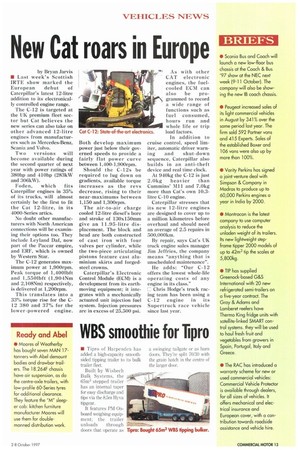New Cat roars in Europe
Page 15

If you've noticed an error in this article please click here to report it so we can fix it.
by Bryan Jarvis • Last week's Scottish 1RTE show marked the European debut of Caterpillar's latest 12-litre addition to its electronically controlled engine range.
The C-12 is targeted at the UK premium fleet sector but Cat believes the new series can also take on other advanced 12-litre engines from manufacturers such as Mercedes-Benz, Scania and Volvo.
Two versions will become available during the second quarter of next year with power ratings of 380hp and 410hp (283kW and 306kW).
Foden, which fits Caterpillar engines in 35% of its trucks, will almost certainly be the first to fit the Cat 12-litre, in its 4000-Series artics.
No doubt other manufacturers with North American connections will be examining their options too. They include Leyland Daf, now part of the Paccar empire, and ERF, which is owned by Western Star.
The C-12 generates maximum power at 1,900rpm. Peak torque of 1,400Ibft and 1,5501bft (1,904Nm and 2,108Nm) respectively, is delivered at 1,200rpm.
This translates into a 33% torque rise for the C12 380 and 37% for the lower-powered engine. Both develop maximum power just below their governed speeds to provide a fairly flat power curve between 1,400-1,900rpm.
Should the C-12s be required to lug down on gradients, available torque increases as the revs decrease, rising to their near-maximums between 1,150 and 1,300rpm.
The air-to-air charge cooled 12-litre diesel's bore and stroke of 130x150mm give an 1I.95-litre displacement. The block and head are both constructed of cast iron with four valves per cylinder, while the two-piece articulating pistons feature cast aluminium skirts and forgedsteel crowns.
Caterpillar's Electronic Control Module (ECM) is a development from its earthmoving equipment; it integrates with a mechanically actuated unit injection fuel system. Injection pressures are in excess of 25,500 psi. As with other CAT electronic engines, the fuelcooled ECM can also be programmed to record a wide range of functions such as fuel consumed, hours run and whole life or trip load factors.
In addition to cruise control, speed limiter, automatic driver warning and shut-down sequence, Caterpillar also builds in an anti-theft device and real time clock.
At 940kg the C-12 is just 2.0kg heavier than Cummins' M11 and 7.0kg more than Cat's own 10.3litre C-10 engine.
Caterpillar stresses that its new 12-litre engines are designed to cover up to a million kilometres before overhaul and should need an average of 2.5 repairs in 500,000km.
By repair, says Cat's UK truck engine sales manager Jim Jeffries, the company means "anything that is unscheduled maintenance".
He adds: "Our C-12 offers the lowest whole-life operating costs of any engine in its class."
L Chris Hodge's truck racing team has been using a C-12 engine in its Supertruck race vehicle since last year.








































































































